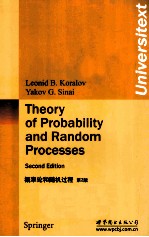

概率论和随机过程 原书第2版 英文PDF电子书下载
- 电子书积分:13 积分如何计算积分?
- 作 者:(美)凯罗勒夫著
- 出 版 社:北京:世界图书北京出版公司
- 出版年份:2012
- ISBN:9787510044106
- 页数:358 页
Part Ⅰ Probability Theory 3
1 Random Variables and Their Distributions 3
1.1 Spaces of Elementary Outcomes,σ-Algebras,and Measures 3
1.2 Expectation and Variance of Random Variables on a Discrete Probability Space 9
1.3 Probability of a Union of Events 14
1.4 Equivalent Formulations of σ-Additivity,Borel σ-Algebras and Measurability 16
1.5 Distribution Functions and Densities 19
1.6 Problems 21
2 Sequences of Independent Trials 25
2.1 Law of Large Numbers and Applications 25
2.2 de Moivre-Laplace Limit Theorem and Applications 32
2.3 Poisson Limit Theorem 34
2.4 Problems 35
3 Lebesgue Integral and Mathematical Expectation 37
3.1 Definition of the Lebesgue Integral 37
3.2 Induced Measures and Distribution Functions 41
3.3 Types of Measures and Distribution Functions 45
3.4 Remarks on the Construction of the Lebesgue Measure 47
3.5 Convergence of Functions,Their Integrals,and the Fubini Theorem 48
3.6 Signed Measures and the Radon-Nikodym Theorem 52
3.7 Lp Spaces 54
3.8 Monte Carlo Method 55
3.9 Problems 56
4 Conditional Probabilities and Independence 59
4.1 Conditional Probabilities 59
4.2 Independence of Events,σ-Algebras,and Random Variables 60
4.3 π-Systems and Independence 62
4.4 Problems 64
5 Markov Chains with a Finite Number of States 67
5.1 Stochastic Matrices 67
5.2 Markov Chains 68
5.3 Ergodic and Non-Ergodic Markov Chains 71
5.4 Law of Large Numbers and the Entropy of a Markov Chain 74
5.5 Products of Positive Matrices 76
5.6 General Markov Chains and the Doeblin Condition 78
5.7 Problems 82
6 Random Walks on the Lattice Zd 85
6.1 Recurrent and Transient Random Walks 85
6.2 Random Walk on Z and the Reflection Principle 88
6.3 Arcsine Law 90
6.4 Gambler's Ruin Problem 93
6.5 Problems 98
7 Laws of Large Numbers 101
7.1 Definitions,the Borel-Cantelli Lemmas,and the Kolmogorov Inequality 101
7.2 Kolmogorov Theorems on the Strong Law of Large Numbers 103
7.3 Problems 106
8 Weak Convergence of Measures 109
8.1 Definition of Weak Convergence 109
8.2 Weak Convergence and Distribution Functions 111
8.3 Weak Compactness,Tightness,and the Prokhorov Theorem 113
8.4 Problems 116
9 Characteristic Functions 119
9.1 Definition and Basic Properties 119
9.2 Characteristic Functions and Weak Convergence 123
9.3 Gaussian Random Vectors 126
9.4 Problems 128
10 Limit Theorems 131
10.1 Central Limit Theorem,the Lindeberg Condition 131
10.2 Local Limit Theorem 135
10.3 Central Limit Theorem and Renormalization Group Theory 139
10.4 Probabilities of Large Deviations 143
10.5 Other Limit Theorems 147
10.6 Problems 151
11 Several Interesting Problems 155
11.1 Wigner Semicircle Law for Symmetric Random Matrices 155
11.2 Products of Random Matrices 159
11.3 Statistics of Convex Polygons 161
Part Ⅱ Random Processes 171
12 Basic Concepts 171
12.1 Definitions of a Random Process and a Random Field 171
12.2 Kolmogorov Consistency Theorem 173
12.3 Poisson Process 176
12.4 Problems 178
13 Conditional Expectations and Martingales 181
13.1 Conditional Expectations 181
13.2 Properties of Conditional Expectations 182
13.3 Regular Conditional Probabilities 184
13.4 Filtrations,Stopping Times,and Martingales 187
13.5 Martingales with Discrete Time 190
13.6 Martingales with Continuous Time 193
13.7 Convergence of Martingales 195
13.8 Problems 199
14 Markov Processes with a Finite State Space 203
14.1 Definition of a Markov Process 203
14.2 Infinitesimal Matrix 204
14.3 A Construction of a Markov Process 206
14.4 A Problem in Queuing Theory 208
14.5 Problems 209
15 Wide-Sense Stationary Random Processes 211
15.1 Hilbert Space Generated by a Stationary Process 211
15.2 Law of Large Numbers for Stationary Random Processes 213
15.3 Bochner Theorem and Other Useful Facts 214
15.4 Spectral Representation of Stationary Random Processes 216
15.5 Orthogonal Random Measures 218
15.6 Linear Prediction of Stationary Random Processes 220
15.7 Stationary Random Processes with Continuous Time 228
15.8 Problems 229
16 Strictly Stationary Random Processes 233
16.1 Stationary Processes and Measure Preserving Transformations 233
16.2 Birkhoff Ergodic Theorem 235
16.3 Ergodicity,Mixing,and Regularity 238
16.4 Stationary Processes with Continuous Time 243
16.5 Problems 244
17 Generalized Random Processes 247
17.1 Generalized Functions and Generalized Random Processes 247
17.2 Gaussian Processes and White Noise 251
18 Brownian Motion 255
18.1 Definition of Brownian Motion 255
18.2 The Space C([0,∞)) 257
18.3 Existence of the Wiener Measure,Donsker Theorem 262
18.4 Kolmogorov Theorem 266
18.5 Some Properties of Brownian Motion 270
18.6 Problems 273
19 Markov Processes and Markov Families 275
19.1 Distribution of the Maximum of Brownian Motion 275
19.2 Definition of the Markov Property 276
19.3 Markov Property of Brownian Motion 280
19.4 The Augmented Filtration 281
19.5 Definition of the Strong Markov Property 283
19.6 Strong Markov Property of Brownian Motion 285
19.7 Problems 288
20 Stochastic Integral and the Ito Formula 291
20.1 Quadratic Variation of Square-Integrable Martingales 291
20.2 The Space of Integrands for the Stochastic Integral 295
20.3 Simple Processes 297
20.4 Deftnition and Basic Properties of the Stochastic Integral 298
20.5 Further Properties of the Stochastic Integral 301
20.6 Local Martingales 303
20.7 Ito Formula 305
20.8 Problems 310
21 Stochastic Differential Equations 313
21.1 Existence of Strong Solutions to Stochastic Differential Equations 313
21.2 Dirichlet Problem for the Laplace Equation 320
21.3 Stochastic Difrerential Equations and PDE's 324
21.4 Markov Property of Solutions to SDE's 333
21.5 A Problem in Homogenization 336
21.6 Problems 340
22 Gibbs Random Fields 343
22.1 Definition of a Gibbs Random Field 343
22.2 An Example of a Phase Transition 346
Index 349
- 《催化剂制备过程技术》韩勇责任编辑;(中国)张继光 2019
- 《绿色过程工程与清洁生产技术 张懿院士论文集精选 上》《绿色过程工程与清洁生产技术》编写组编 2019
- 《化工传递过程导论 第2版》阎建民,刘辉 2020
- 《钢铁行业污染特征与全过程控制技术研究》周长波等 2019
- 《概率论与数理统计》傅丽芳 2018
- 《钢铁烧结烟气多污染物过程控制原理与新技术》甘敏,范晓慧著 2019
- 《食品过程工程》赵黎明主编 2020
- 《工业过程控制及安全技术》王华忠编著 2019
- 《舰艇武器控制中的随机过程应用基础》卢发兴 2019
- 《过程工程原理实验》章茹,秦伍根,钟卓尔主编 2019
- 《TED说话的力量 世界优秀演讲者的口才秘诀》(坦桑)阿卡什·P.卡里亚著 2019
- 《小手画出大世界 恐龙世界》登亚编绘 2008
- 《近代世界史文献丛编 19》王强主编 2017
- 《课堂上听不到的历史传奇 世界政治军事名人 初中版》顾跃忠等编著 2015
- 《指向核心素养 北京十一学校名师教学设计 英语 七年级 上 配人教版》周志英总主编 2019
- 《365奇趣英语乐园 世界民间故事》爱思得图书国际企业 2018
- 《近代世界史文献丛编 36》王强主编 2017
- 《北京生态环境保护》《北京环境保护丛书》编委会编著 2018
- 《近代世界史文献丛编 11》王强主编 2017
- 《近代世界史文献丛编 18》王强主编 2017
